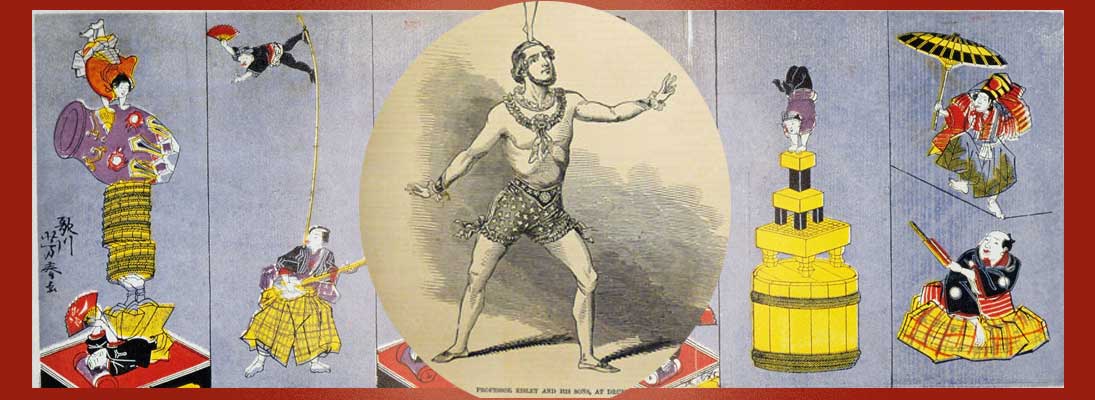
Professor Risley and the Imperial Japanese Troupe
How an American Acrobat Introduced Circus to Japan--And Japan to the West
Story
Why write a book about Professor Risley and the Imperial Japanese Troupe?

Several years ago in Japan, I came across mentions of Professor Risley and the Imperial Japanese Troupe.I have long been interested in early contacts between Japan and North America, and as a result I was doubly surprised that I had never heard of such an extraordinary person, or of the amazing troupe he put together. I was, frankly, fascinated.

Professor Risley and Sons in the "Risley Act," in Paris, circa 1843-44.
The Imperial Japanese Troupe left Yokohama in late 1866, and spent over two years touring North America and the capitals of Europe. They were seen by crowds of thousands that included the literate and illiterate, commoners and aristocrats, and even royalty.
In Washington D.C., they met with President Andrew Johnson and toured the White House. They became global sensations, something that nearly everyone talked about. One of the younger members of the troupe--Hamaikari Umekichi, known to Americans as "Little All Right"-- even became a household word. Popular composers dedicated music for him, and his name was later used to advertised all sorts of products, including cigars and derringers. Yet by the early twentieth century, the Imperials had largely disappeared into history, and been forgotten.
The more I began looking into the story, the more I realized that the Imperial Japanese Troupe was also part of a larger, lost history--of how Japanese acrobats were some of the first ordinary citizens to travel to the West, and how they were once hugely popular in the West. The Imperial Japanese Troupe was followed by multiple other Japanese acrobatic troupes, usually headed for America and Europe, but later for Australia, too. They coexisted in time with the Japonisme art movement, yet they had little in common with that movement except for their “Japanese-ness.” Instead of "things," these acrobats were people--ordinary Japanese commoners who were traveling overseas and viewing the West for the first time. And they were seen by ordinary Europeans and Americans who were ogling the exotic performers from the East, often for the first time. In the late 19th century, far more Americans and Europeans saw Japanese acrobats than saw Japanese art works, especially the woodblock prints that inspired the Japonisme art movement.

The Imperials in London, 1868.
The boom in Japanese acrobats was triggered by the work of "Professor Risley," the stage name of Richard Risley Carlisle, a charismatic American acrobat who had himself once been a global star, juggling his two sons to fame. Like the late 19th century boom in Japanese acrobats, Risley is largely forgotten today (except for the "Risley act," which is still being performed in circuses). Risley's biggest contribution to the world was ultimately his introduction of Western circus to Japan, and of Japanese acrobats to the West.

American children imitating the Imperials' tub act, circa 1867.
Why had I never heard of Risley before? Why had I never heard of his Imperial Japanese Troupe? As with other books I have written, I started this one to answer questions I had, to learn, and to share what I learned with a wider audience. In the process, I had an enormous amount of fun. And I came to see the world in an entirely new light. Instead of orthodox history, I was able to see history through the eyes of some of the early unsung pioneers of global culture exchange--the fearless professional entertainers who took enormous personal risks to cross borders and oceans, and to spread good will.
--I am deeply indebted to the kindness of many people, who assisted me in my research and while writing. And I would like to pay especial tribute to Aya Mihara (三原文), the pre-eminent Japanese scholar on acrobatic troupes of the late 19th century. She graciously encouraged me, supplied me with information and opinions, and consented to proof my manuscript. Her sudden passing, in October 2013, was a catastrophic loss to all those interested in this esoteric field of study.合掌.
 Professor Risley and the Imperial Japanese Troupe: How an American Acrobat Introduced Circus to Japan--And Japan to the West was published by the intrepid Stone Bridge Press, of Berkeley, California, in 2013. It won the Stuart Thayer Prize from the Circus Historical Society. It is available for order through finer bookstores (please also ask them to stock it), as well as on Amazon, Barnes and Noble and other on-line retailers. It is also available as an ebook on the Amazon Kindle platforms for PC, Macs, and tablets as well as other platforms.
Professor Risley and the Imperial Japanese Troupe: How an American Acrobat Introduced Circus to Japan--And Japan to the West was published by the intrepid Stone Bridge Press, of Berkeley, California, in 2013. It won the Stuart Thayer Prize from the Circus Historical Society. It is available for order through finer bookstores (please also ask them to stock it), as well as on Amazon, Barnes and Noble and other on-line retailers. It is also available as an ebook on the Amazon Kindle platforms for PC, Macs, and tablets as well as other platforms.
--Back to top--

